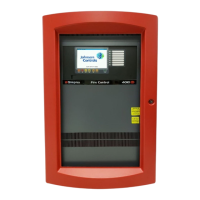page 55 579-1150 Rev M
4010ES IDNAC Fire Alarm System Installation Guide
7.2.1 Device wiring guidelines
Review the following guidelines for devices before you begin the field wiring.
• Only IDNAC appliances and other compatible appliances are allowed on the IDNAC SLCs. See the appendix for a list of compatible
appliances.
• Maximum of 127 appliances or 139 unit loads per channel. The maximum number of visuals that can be synchronized on one circuit
is 127.
• Maximum of six TrueAlert Addressable isolators between any appliance and SLC terminals. Maximum 12 isolators per SLC.
• Maximum of 30 appliances connected directly to any isolator terminal pair.
• All wiring is 20 AWG to 12 AWG.
• The required wiring is unshielded Twisted Pair. This wiring must have a capacitive rating of less than 60pF/ft and a minimum 3 twists
(turns) per foot.
• All wiring is supervised and power-limited.
• The maximum alarm current is 3 A per circuit.
• Maximum cable load is 10,000 feet (3,048 m) per channel. Maximum wire length from panel to any appliance is 4,000 feet (762 m).
• The nominal voltage rating is 29 VDC.
• The total available current from the ESS is 6 A.
• All visible appliances wired from an ESS are synchronized to appliances on SPS, XPS, TPS, 4009A, 4009T and other ESS within the
system. Appliances wired from TrueAlert Adapter (4905-9816) are not synchronized to other system appliances.
7.2.2 Ferrite beads
Ferrite beads must be used for field wiring.
1. Install the ferrite bead close to the ESS field wiring terminals for lowest radiated emissions (before the wires leave the box).
2. Loop the wires through the bead as shown.
Figure 43: Ferrite bead installation
7.2.3 Class B wiring tables
Use the following tables to calculate the wiring distance.
Maximum wiring distance is the shorter of the distance limits as calculated by alarm current voltage drop or by reaching the
communications distance limit.
Note: Wiring distance must not exceed 4000 ft
Note: Although the required wire IDNAC circuits is twisted pair (controlled impedance) wiring, some applications will wish to take advan-
tage of existing wiring that is not twisted pair. This is only allowed if both conductors of the IDNAC circuit reside in the same metal conduit,
and only under certain conditions. Check with your local sales office before using wiring that is not twisted pair.

